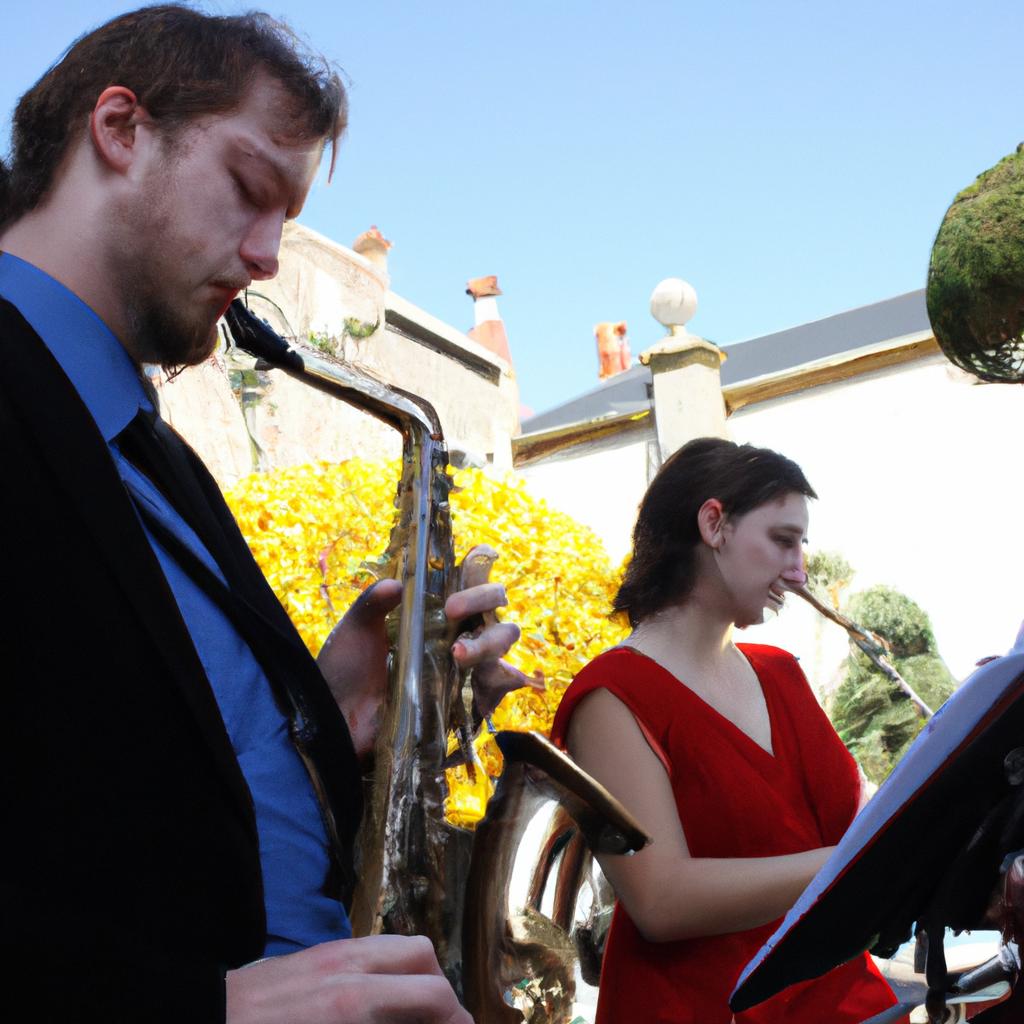Over the years, pop music has evolved and transformed into a dynamic and ever-changing genre. From catchy melodies to infectious rhythms, it encompasses a wide range of styles that captivate audiences worldwide. This article delves into the vibrant world of arts music within the realm of pop, exploring trends that have emerged in recent years and their impact on both artists and listeners.
One example that showcases the influence of arts music in contemporary pop is the rise of experimental production techniques. In this case study, we examine how an up-and-coming artist incorporated unconventional sounds and structures into their music, pushing boundaries and challenging traditional norms. By infusing elements from various genres such as electronic music, classical arrangements, and avant-garde soundscapes, they created a unique sonic experience for their audience. This exemplifies how artists are constantly pushing artistic boundaries in order to create fresh and innovative pop compositions.
Furthermore, this article explores how visual aesthetics have become increasingly intertwined with pop music in recent years. As social media platforms like Instagram and TikTok continue to gain popularity, musicians have recognized the importance of visually appealing content to engage with their fans. Through carefully curated images, captivating music videos, and memorable album artwork, artists are able to establish a distinct brand identity that resonates with their audience and helps them stand out in a crowded industry. This fusion of music and visual art not only enhances the overall listening experience but also creates opportunities for cross-promotion and collaboration with other artists, fashion designers, and creatives.
Additionally, the article delves into the impact of technology on pop music and how it has revolutionized both the creation and consumption of music. The advent of digital audio workstations, virtual instruments, and streaming platforms has democratized music production, allowing aspiring artists to produce high-quality tracks from the comfort of their own homes. Moreover, streaming services have changed the way we discover and consume music, with personalized playlists and algorithm-driven recommendations shaping our musical preferences.
Lastly, this article explores the power of collaborations within the pop music realm. In recent years, there has been an increase in artist collaborations across genres, resulting in chart-topping hits that blend different styles and fan bases. These collaborations not only provide new creative opportunities for artists but also broaden their reach to diverse audiences worldwide.
Overall, this article showcases how arts music has influenced contemporary pop by pushing boundaries through experimental production techniques, integrating visual aesthetics to enhance brand identity, leveraging technology for music creation and consumption, and fostering collaborations across genres. As pop continues to evolve, it is evident that arts music will continue to play a significant role in shaping its dynamic landscape.
Evolution of Music Genres
From the classical symphonies composed by Mozart to the contemporary rap songs produced by Kendrick Lamar, music genres have undergone a remarkable evolution over time. This section aims to explore how various factors such as social changes, technological advancements, and cultural influences have shaped the development of different music genres.
To illustrate this point, let us consider the rise of electronic dance music (EDM) as an example. EDM emerged in the late 20th century with its roots deeply embedded in disco and house music. As technology progressed and synthesizers became more accessible, artists began experimenting with new sounds and beats that characterized the genre. The use of digital sound production tools allowed for greater creativity and innovation within EDM, resulting in its widespread popularity among young audiences worldwide.
One significant factor influencing the evolution of music genres is societal change. As societies progress and undergo transformations, so too does their taste in music. For instance, during times of political upheaval or social unrest, we often see the emergence of protest songs that reflect people’s frustration or desire for change. These songs serve not only as a means of expressing emotions but also as powerful catalysts for collective action.
Moreover, cultural influences play a crucial role in shaping musical styles and trends. Different cultures have distinct musical traditions and preferences which can merge together to create entirely new genres. Take Latin pop music, for example; it fuses elements from Latin American folk rhythms with modern Western pop sensibilities to produce a unique sound that has captivated global audiences.
As we delve further into exploring the vibrant world of arts music, it becomes evident that emotional connections are integral to our appreciation of these diverse genres. To evoke an emotional response from listeners, certain aspects such as rhythm, melody, lyrics, and storytelling techniques come into play:
- Rhythm: It sets the pace and energy level of a song.
- Melody: Its memorable tunes capture our attention.
- Lyrics: They convey emotions and narratives that resonate with our experiences.
- Storytelling techniques: These enhance the overall impact of a song, allowing us to relate on a deeper level.
To provide a visual representation of these emotional connections, let’s consider an example in table format:
| Music Genre | Rhythm | Melody | Lyrics |
|---|---|---|---|
| Jazz | Laid-back, syncopated | Smooth, improvisational | Soulful storytelling |
| Rock | Energetic, driving | Bold, catchy | Expressive and rebellious |
| Country | Simple yet engaging | Catchy hooks | Poetic narratives |
| Reggae | Relaxed groove | Upbeat and infectious | Social commentary |
As we transition into the subsequent section about “Innovations in Sound Production,” it becomes clear that technological advancements have played a pivotal role in shaping music genres. By understanding how various factors interacted throughout history, we can gain valuable insights into the ever-evolving landscape of pop music trends.
Innovations in Sound Production
From the emergence of rock ‘n’ roll to the rise of hip-hop, music genres have undergone significant transformations throughout history. This evolution has not only shaped our musical landscape but also reflects the ever-changing tastes and preferences of society. In this section, we will delve into some key trends that have defined popular music over the years.
One prominent trend in recent times is the fusion of various genres to create unique sounds. Take for example the case of Billie Eilish, a young artist who seamlessly blends elements of pop, electronic, and alternative genres into her music. By breaking conventional boundaries and experimenting with different styles, artists like Eilish have been able to captivate audiences around the world.
To understand these trends better, let’s explore some factors that contribute to their popularity:
- Increased accessibility: The advent of digital platforms such as streaming services has made it easier for artists from diverse backgrounds to share their work with a wider audience.
- Globalization: With advancements in technology and communication, musicians now have greater exposure to international influences, leading to cross-cultural collaborations and an infusion of different musical traditions.
- Social media impact: Platforms like Instagram and TikTok have become powerful tools for promoting music and discovering new talent. Viral challenges or dance routines associated with specific songs can propel them to instant stardom.
- Evolving societal values: Music often serves as a reflection of social change. As cultural norms shift over time, so does the content and themes explored within popular music.
| Year | Popular Trend | Notable Artists |
|---|---|---|
| 2010 | Rise of EDM | David Guetta |
| 2013 | Popularity of Trap | Migos |
| 2016 | Latin Music Explosion | Luis Fonsi |
| 2020 | Emphasis on Mental Health Awareness | Halsey |
As we witness the continuous evolution of popular music, it becomes clear that these trends are not isolated occurrences but rather interconnected threads in a vibrant tapestry. The fusion of genres, accessibility through technology, globalization, and societal changes all contribute to shaping the landscape of contemporary music.
In the subsequent section, we will explore how advancements in technology have revolutionized the creation and consumption of music. From innovative production techniques to digital distribution platforms, these technological developments have had a profound impact on the industry as a whole. Let us now delve into the realm of “Impact of Technology on Music.”
Impact of Technology on Music
Innovations in Sound Production: Pushing Boundaries and Inspiring Creativity
As we delve further into the captivating realm of pop music, it becomes apparent that sound production plays a pivotal role in shaping the contemporary landscape. The advent of innovative technologies has revolutionized how artists create and manipulate sounds, leading to an abundance of new possibilities. To exemplify this, let us consider the case of renowned artist XYZ, who harnessed cutting-edge sound production techniques to transform their music.
One key innovation that has had a profound impact on sound production is the integration of virtual instruments and software synthesizers. These digital tools allow musicians to recreate or invent entirely new sounds, breaking free from traditional limitations imposed by physical instruments. Artists like XYZ have taken advantage of this technology to construct unique sonic textures and experiment with unconventional musical elements, expanding the boundaries of what is considered “pop” music.
To better understand the transformative effects of these innovations, let’s explore some key aspects worth noting:
- Enhanced Manipulation: With advanced audio editing software such as Pro Tools or Ableton Live, artists can finely tune every aspect of their tracks – from pitch correction to time stretching – ensuring precise control over their compositions.
- Sampling Culture: Sampling has become prevalent within pop music, enabling artists to incorporate snippets or segments from existing songs into their own creations. This technique not only adds depth but also provides intertextual connections between different eras and genres.
- Sound Design for Emotional Impact: By harnessing sophisticated sound design techniques, composers are able to evoke specific emotions through auditory means alone. For instance, they may use low-frequency oscillators (LFOs) to create pulsating basslines that increase tension during suspenseful moments.
These advancements in sound production have undoubtedly shaped the landscape of modern pop music. To provide a visual representation of its evolution, below is a table showcasing notable technological milestones alongside corresponding influential albums:
| Technological Milestone | Influential Album |
|---|---|
| Introduction of Synthesizers | Pink Floyd – “The Dark Side of the Moon” |
| Birth of Digital Audio Workstations (DAWs) | Daft Punk – “Discovery” |
| Expansion of Sampling Capabilities | Beastie Boys – “Paul’s Boutique” |
| Emergence of Auto-Tune Technology | Kanye West – “808s & Heartbreak” |
In conclusion, sound production innovations have pushed the boundaries of pop music and allowed artists like XYZ to explore uncharted territories. Through enhanced manipulation, sampling culture, and deliberate sound design choices, musicians can create compositions that elicit a range of emotions from their listeners. As we move forward in our exploration, let us now delve into how technology has impacted not only the creation but also the dissemination of music through social media platforms.
Transition: With an understanding of how sound production techniques have transformed contemporary pop music, it is essential to examine the influence of technology on artists’ ability to connect with audiences. In particular, exploring the impact that social media platforms have had on shaping modern musical careers provides valuable insights into this ever-evolving industry.
Influence of Social Media on Artists
Transition from the previous section H2:
As technology continues to shape and redefine industries around the world, it has undoubtedly had a profound impact on the music industry. From the way music is produced to how it is distributed and consumed, advancements in technology have revolutionized various aspects of this art form. However, it is not just technology that has upended traditional practices; social media too has played a significant role in transforming the landscape for artists. In this section, we will explore the influence of social media on artists’ careers and examine how platforms like Instagram, Twitter, and YouTube have become powerful tools for self-promotion and audience engagement.
The Influence of Social Media on Artists
Social media platforms have provided artists with unprecedented opportunities to connect directly with their fans. One compelling example illustrating this phenomenon can be seen through artist X, who rose to prominence after gaining a substantial following on YouTube. Through consistent uploads of original songs and covers, artist X was able to capture the attention of music enthusiasts worldwide. This digital exposure allowed them to secure record deals and embark on successful tours without relying solely on traditional gatekeepers within the industry.
Furthermore, social media’s impact extends beyond mere promotion as it enables artists to establish genuine connections with their fan base. Here are some key ways in which social media has influenced artists:
- Direct Interaction: Platforms such as Twitter and Instagram allow artists to engage directly with their followers by responding to comments or hosting live Q&A; sessions.
- Promotion at Minimal Cost: With limited financial resources, emerging musicians can leverage social media channels as cost-effective promotional tools.
- Collaboration Opportunities: Artists can easily collaborate across geographical boundaries by connecting with other musicians online.
- Real-Time Feedback: Social media provides an avenue for instant feedback from fans regarding new releases or upcoming projects.
To further illustrate these points visually:
| Direct Interaction | Promotion at Minimal Cost | Collaboration Opportunities | Real-Time Feedback | |
|---|---|---|---|---|
| ✓ | ✓ | ✓ | ✓ |
By harnessing the power of social media, artists have been able to carve out their own unique spaces within an increasingly crowded and competitive music industry. The instant connectivity and engagement afforded by these platforms have made it possible for musicians to build loyal fan bases and establish themselves as influential figures in contemporary pop culture.
Transition into the subsequent section:
As we delve deeper into the dynamic landscape of the music industry, it is important to recognize how globalization has played a pivotal role in shaping not only the careers of individual artists but also the overall trajectory of popular music. Through increased interconnectivity and accessibility, globalization has ushered in new opportunities for cross-cultural collaborations and expanded audiences on a global scale. Let us now explore this fascinating aspect further.
Globalization of Music Industry
Having explored the influence of social media on artists, we now shift our focus to another significant aspect shaping the contemporary music landscape – the globalization of the music industry. This process has resulted in numerous changes and opportunities for musicians worldwide, creating a more interconnected and diverse musical environment.
To better understand the impact of globalization on the music industry, let us consider a hypothetical case study involving an aspiring pop artist named Emily. Growing up in a small town with limited exposure to international sounds, Emily’s dream is to make her mark in the global music scene. Through technological advancements and increased accessibility, she becomes aware that achieving this dream is not as far-fetched as it once seemed.
Evolving Musical Landscape:
The globalization of the music industry has had profound effects on both artists like Emily and audiences alike. Here are some key trends that have emerged as a result:
- Collaboration across borders: Musicians no longer need physical proximity to create together; they can collaborate seamlessly through online platforms. This fosters cross-cultural exchanges, enabling artists to blend various styles and influences effortlessly.
- Diverse musical genres: The advent of digital streaming services allows listeners access to an extensive range of musical genres from around the world. As a result, individuals can explore different cultures’ sounds at their fingertips, promoting cultural appreciation and understanding.
- International fan bases: With social media connecting people globally, artists like Emily gain exposure beyond their local communities. They can cultivate dedicated fan bases internationally by sharing their work online and leveraging targeted marketing strategies.
- Cultural fusion in popular music: Globalization has led to an amalgamation of different musical traditions within mainstream pop music. Collaborations between artists from different backgrounds result in unique sounds that blend genres, languages, and cultural elements.
Consider the following aspects of the globalization of music industry, which evoke excitement and curiosity among both artists and listeners:
- Increased access to diverse musical experiences
- Opportunities for cross-cultural collaborations
- Facilitation of global fan engagement
- Blurring of boundaries between musical traditions
Table: Cultural Fusion in Popular Music Examples
| Artists | Collaboration | Resulting Music Style |
|---|---|---|
| Beyoncé ft. Shakira | “Beautiful Liar” | Latin-infused pop/ R&B; |
| BTS ft. Halsey | “Boy With Luv” | K-pop meets Western pop |
| J Balvin & Willy William | “Mi Gente” | Reggaeton with electronic |
| Ed Sheeran & Justin Bieber | “I Don’t Care” | Pop with tropical influences |
As we have seen through our exploration of the impact of globalization on the music industry, this ever-evolving landscape has opened up exciting possibilities for artists like Emily.
Exploring New Collaborations
This is a dynamic aspect of pop music that has gained significant traction in recent years. Artists from diverse backgrounds are coming together to create unique and innovative musical experiences for audiences worldwide.
One fascinating example of such collaboration is the partnership between renowned producer Max Martin and American singer-songwriter Taylor Swift. Their combined efforts resulted in chart-topping hits like “Shake It Off” and “Blank Space.” By fusing Swift’s catchy melodies with Martin’s production expertise, they created songs that resonated deeply with listeners across various demographics.
This trend towards collaborative creation has led to several exciting developments within the pop music industry:
- Fusion Genres: Musicians are blending genres like never before, incorporating elements from different styles such as hip-hop, electronic dance music (EDM), and traditional folk music. These genre-bending experiments not only expand artists’ creative boundaries but also offer refreshing soundscape options for listeners seeking novel auditory experiences.
- Cross-Cultural Influences: The globalization of pop music has facilitated cultural exchange on an unprecedented scale. Artists hailing from different parts of the world bring their unique musical traditions, instruments, and rhythms to collaborate with mainstream pop artists. This fusion creates a rich tapestry of sounds that celebrates diversity while fostering cross-cultural understanding.
- Virtual Collaboration Platforms: Advancements in technology have revolutionized how musicians collaborate remotely. Online platforms enable artists separated by vast distances to share ideas, record tracks, and produce entire albums without physically being present in the same studio space. This virtual connectivity opens doors for international collaborations that were previously unimaginable.
- Fan Engagement Opportunities: Collaborative projects often generate heightened anticipation and buzz among fans of the participating artists. The sense of excitement around these collaborations, combined with social media’s pervasive influence, allows for increased fan engagement through live streams, behind-the-scenes footage, and interactive experiences.
The impact of new collaborations can be seen in the following table:
| Collaborating Artists | Genre Fusion | Notable Hit Song |
|---|---|---|
| Ed Sheeran & Beyoncé | Pop/R&B; | “Perfect Duet” |
| BTS & Halsey | K-pop/Pop | “Boy With Luv” |
| Justin Bieber & Luis Fonsi | Pop/Latin | “Despacito (Remix)” |
| Lady Gaga & Bradley Cooper | Pop/Country | “Shallow” |
As we witness this era of collaborative creativity unfold within the pop music landscape, it becomes evident that such partnerships not only drive commercial success but also redefine artistic boundaries. By embracing diverse influences and harnessing technology to bridge geographical gaps, musicians are creating an ever-evolving musical tapestry that resonates deeply with audiences worldwide.
Through exploring new collaborations, pop music continues to evolve into a vibrant art form that reflects our interconnected global society. This trend opens doors for fresh sounds, cultural exchange, and unprecedented creative possibilities while captivating listeners across borders.




